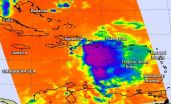A technique designed to predict how much energy waves will be bringing
The EOLO group (UPV/EHU-University of the Basque Country) has developed a technique to forecast wave energy several hours in advance
2015-08-31
(Press-News.org) This news release is available in Spanish.
Marine energy has a great future potential according to the experts, but there is still a long way to go before it can be used on a large scale. Despite the problem of intermittency, wave energy has an advantage over wind energy, for example: it is easier to predict optimum swell than some suitable gusts of wind. That is why knowing how much energy the waves will be bringing within a few hours is as important as having available efficient prototypes to make use of wave power. If this information is known, the energy produced by waves can be incorporated more easily into the mains, and renewable energy consumption can be increased at the same time.
The EOLO group (UPV/EHU) has developed various models for predicting the amount of wave energy for the Bay of Biscay, by using a technique called random forests. "Random forests (RF) is an algorithm developed in recent years in the field of machine learning. The basis of RFs are the so-called 'regression trees', in which the input variables are regarded as roots and the output ones, the leaves. Hence the name 'tree'. Random forest is a development of the regression trees which uses many trees (over a thousand, as a general rule) rather than just one, thus forming a forest," explained Gabriel Ibarra of the EOLO group.
According to this researcher, the models developed by his group are more reliable than other ones already existing for predictions for the next three to sixteen hours. The EOLO models are based on a historical set of measurements that compare the energy levels of the waves at a given moment with each other and with those that are anticipated within a few hours. The measurements are made by means of buoys, five of which are in place in the Bay of Biscay, three off the Galician coast and two out at sea. The Spanish Ports Authority undertakes to maintain the buoys stationed in Galicia and the British meteorological service (MetOffice) the ones out at sea.
Climate change and swell
The EOLO group has two priorities with the future in mind: firstly, to access the data of the WRF Weather Research and Forecasting meteorological model in real time as this will enable it to improve the current results; and secondly, to go on exploring the climate scenarios that could emerge in the future. In fact, climate change is also affecting swell and the storms that routinely batter the Basque coast. In the view of the EOLO members, it is important to know how marine energy is expected to evolve over the coming decades. And this is in fact the focus of its research effort. In any case, the research into predicting wave energy has only just begun and they have yet to reach the operational stage, in other words, it has yet to be applied directly.
The first operational facilities to make use of marine energy were set up in Portugal in 2008. In the Basque Country the small facility in Mutriku was officially opened in 2011. The Mutriku facility functions with OWC technology and sends the energy it produces to the mains. Then there is the BIMEP (Biscay Marine Energy Platform), which reports to the EVE, the Basque Autonomous Community's Energy Board; it will shortly be setting up a testing platform to try out prototypes using the activity of real waves.
INFORMATION:
Bibliographical references:
G. Ibarra-Berastegi, J. Saénz, G. Esnaola, A. Ezcurra, A. Ulazia (2015) "Short-term forecasting of the wave energy flux: Analogues, random forests, and physics-based models". Ocean Engineering, doi: 10.1016/j.oceaneng.2015.05.038. 104. 530-539. 2015
ELSE PRESS RELEASES FROM THIS DATE:
2015-08-31
PITTSBURGH, Aug. 31, 2015 -- People with hostile personality traits who watch more television than their peers may be at a greater risk for injury, potentially because they are more susceptible to the influence of television on violence and risk-taking behaviors, a University of Pittsburgh Graduate School of Public Health analysis discovered.
The research, published online in the International Journal of Injury Control and Safety Promotion, suggests that a reduction in television viewing and content rating systems geared not just to age, but also personality traits, ...
2015-08-31
Life on an island isn't always easy. To make the most of the little there is to eat on many Greek islands, the digestive system of Balkan green lizards has evolved considerably compared to family members on the mainland. Surprisingly, many of these insect-eating lizards even have special valves that help to digest plants. These are some of the findings¹ from a study led by Konstantinos Sagonas of the National and Kapodistrian University of Athens in Greece, published in Springer's journal The Science of Nature².
Reptiles can adjust their digestive system and ...
2015-08-31
PITTSBURGH, Aug. 31, 2015 -- The more hours young adults spend watching television each day, the greater the likelihood that they'll have a higher body mass index and bigger waist circumference, a 15-year analysis by the University of Pittsburgh Graduate School of Public Health revealed.
The association did not hold in later years, indicating that young adulthood is an important time to intervene and promote less television viewing, according to the research published online in the journal SAGE Open.
"We were quite surprised to find that television viewing was associated ...
2015-08-31
ROCHESTER Minn. -- A team of Mayo Clinic Cancer Center scientists has been awarded a Specialized Program of Research Excellence (SPORE) grant in multiple myeloma from the National Cancer Institute. The Mayo Clinic Cancer Center is one of only three cancer centers to receive a SPORE grant for multiple myeloma cancer research.
MULTIMEDIA ALERT: Video and audio are available for download on the Mayo Clinic News Network.
"With project leaders from Mayo campuses in Arizona, Rochester and Florida, our SPORE team will study the genetic basis for myeloma, develop novel viral ...
2015-08-31
Satellite data from NOAA's GOES-East satellite was made into an animation that showed the demise of former Tropical Storm Erika as it neared eastern Cuba early on August 29.
At NASA's Goddard Space Flight Center in Greenbelt, Maryland, NASA/NOAA's GOES Project compiled three days' worth of imagery from NOAA's GOES-East satellite that showed the movement and changes in former Tropical Storm Erika from August 27 to August 29. The animation showed Erika move through the Leeward Islands and into the Eastern Caribbean Sea, as its center passed just south of Puerto Rico, then ...
2015-08-31
London, UK - 30 Aug 2015: Recruitment of leukocytes is a hallmark of stent thrombosis, according to results from the PRESTIGE study presented today at ESC Congress1 and published in European Heart Journal.2 The findings suggest that immune cell mediated thrombotic processes may be a realistic target for novel therapies to prevent stent thrombosis.
"Stent thrombosis (ST) is a life-threatening complication of percutaneous coronary intervention and recent large scale clinical registries reported an incidence of up to 0.4-0.6% per year," said principal investigator Professor ...
2015-08-31
How did the ankylosaur get its tail club? According to research from North Carolina State University and the North Carolina Museum of Natural Sciences that traces the evolution of the ankylosaur's distinctive tail, the handle arrived first on the scene, and the knot at the end of the tail followed.
The typical ankylosaur had a wide armored body and a flexible tail. But one group of ankylosaurs - ankylosaurids - also had a tail club that could have served as a useful weapon. These "weaponized" ankylosaurids lived about 66 million years ago, during the Cretaceous period. ...
2015-08-31
LONDON (Aug. 31, 2015) -- Cardiologists failed to identify more than half of basic and about 35 percent of advanced pre-recorded murmurs, but skills improved after a 90 minute training session, according to research presented today at the European Society of Cardiology Congress 2015.
Recent breakthroughs in the transcatheter treatment of aortic and mitral valve disorders provide new therapies for patients, but physicians must be able to detect valve problems in a timely manner for patients to see the full benefit of these advances, said Michael Barrett, MD, the lead ...
2015-08-31
London, UK - 31 Aug 2015: A gene associated with sudden cardiac death in the general population has been identified using implantable cardioverter defibrillator (ICD) monitoring in research presented for the first time at ESC Congress today.1 The research included patients from the DISCOVERY trial and Oregon-SUDS and discovered that a polymorphism in the GNAS gene predicted ventricular tachyarrhythmias and sudden cardiac death.
"This is the first time a gene has been identified using ICD monitoring and then confirmed to be associated with sudden cardiac death in the general ...
2015-08-31
LONDON, UK - 30 August, 2015: In patients with type 2 diabetes and acute coronary syndrome, the glucose-lowering medication lixisenatide did not increase or decrease the rate of cardiovascular (CV) events compared to placebo, according to results of the Evaluation of Lixisenatide in Acute Coronary Syndrome (ELIXA) trial.
The study, presented today at ESC Congress 2015, "demonstrates the cardiovascular safety of lixisenatide", reported Eldrin F. Lewis, MD, MPH, a member of the ELIXA trial's executive committee, a physician in the Cardiovascular Medicine Division at Brigham ...
LAST 30 PRESS RELEASES:
[Press-News.org] A technique designed to predict how much energy waves will be bringing
The EOLO group (UPV/EHU-University of the Basque Country) has developed a technique to forecast wave energy several hours in advance


